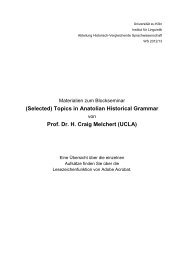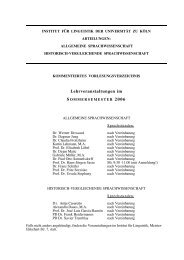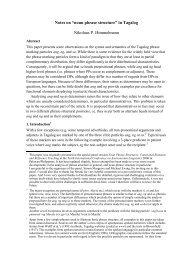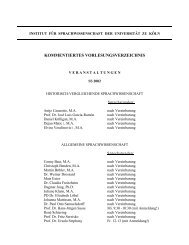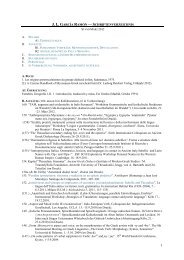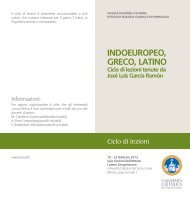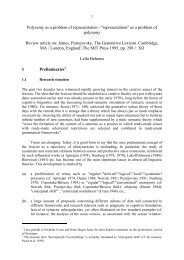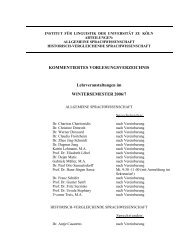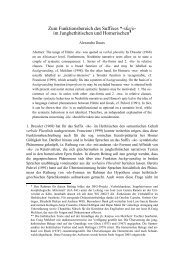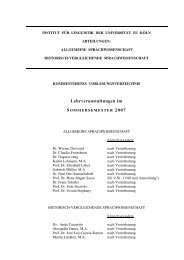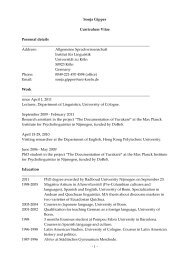Gesamtverzeichnis (pdf) - Institut für Linguistik - Universität zu Köln
Gesamtverzeichnis (pdf) - Institut für Linguistik - Universität zu Köln
Gesamtverzeichnis (pdf) - Institut für Linguistik - Universität zu Köln
Create successful ePaper yourself
Turn your PDF publications into a flip-book with our unique Google optimized e-Paper software.
109. „Zwei neue Namen auf der Stele der Menandridai (Krannon): Χειραίνετος und Ἐρραίνας (= Ἐρί-αινος) und<br />
die griechische dichterische Phraseologie“. ZPE 159, 2007, 179–188.<br />
108. „Anthroponymica Mycenaea: 5. a-wi-to-do-to /Awisto-dotos/ und die unsichtbaren Götter im Alph.-<br />
Griechischen. 6. we-re-na-ko und Myk. */wrēn/ : alph.-gr. °ρρην-, ἀρήν“. ŽAnt 55, 2005 (volume<br />
dedicated to Petar Hr. Ilievski), 85–97.<br />
107. „Mykenisch qe-ja-me-no und e-ne-ka a-no-qa-si-ja, alph.-gr. τεισάμενoς und ἀνδρoκτασία ‘Mord’ und der PN<br />
Τεισίφoνoς“. Festschrift Stefan Hiller, Wien 2007, 113–123.<br />
106. „La fragmentación dialectal griega: posibilidades, limitaciones y falsos problemas“. IncL 29, 2006, 61–82.<br />
105. „Ererbtes und Ersatzkontinuanten bei der Rekonstruktion von indogermanischen Konstruktionsmustern: idg.<br />
*ĝ h eu̯ - und heth. lah(h)u- hhi ‘giessen’“. Evidence and Counter-Evidence (Festschrift Frederik<br />
Kortlandt). Amsterdam-New York 2008, 151–170.<br />
104. „Update on Die historischen Personennamen des Mykenischen“. Indo-European Studies Bulletin (UCLA Los<br />
Angeles) 11, 2005, 24–33.<br />
103. „Der thessalische Name Σπύραγος, σπυρός ‘Weizen(korn)’ und att. πυρός, πυροὺς ἄγειν ‘Weizen(korn) <strong>zu</strong><br />
Wasser transportieren‘”. Fs Gert Klingenschmitt, Regensburg 2006, 127–144.<br />
102. „Hitita u̯ arr- ‘ayudar’ y karii̯ a- mi/tta ‘mostrar benevolencia’, hom. ἦρα φέρειv (y χάριv φέρειv) ‘dar<br />
satisfacción’, IE *u̯ erH- ‘favorecer’ y *ĝ h er(H)- ‘estar a gusto, desear’”. Studi in onore Roberto<br />
Gusmani, Alessandria 2006, 825–846.<br />
101. (& Br. Helly): „Contribution à la grammaire du thessalien: formes dialectales et narration rhétorique pour<br />
une histoire quasi-romanesque dans un nouveau décret de Larisa“. In einer Festschrift, im Druck.<br />
100. (& A. Tzafalias - Br. Helly) : „Décrets inédits de Larisa (2)”, BCH 130/1, 2006, 435–483.<br />
99. „Les thèmes aspectuels dans les inscriptions thessaliennes“. L’aspect dans les dialectes grecs. Actes du<br />
colloque de l’université de Saint-Etienne, 17–18 juin 2004, Nancy 2008, 91–124.<br />
98. „Av. Yuxtāspa- und av.ap. Vīštāspa-, griech. Ζεύξιππος, Ἱππόλυτος bzw. Λύσιππος“. Fs Leonard Herzenberg<br />
(Sankt Petersburg), 2005, 323–331.<br />
97. „Homme comme force, force d´homme: un motif onomastique et l’étymologie du vieux-irlandais gus”. Langue<br />
poétique indo-européenne (Colloque de l‘ Indogermanische Gesellschaft, Paris, 22.–24.10.2003).<br />
Louvain-la-Neuve 2006, 79–93.<br />
96. „Antroponimia griega: entre el léxico común y la fraseología indoeuropea“. Eröffnungsvortrag Congreso de<br />
la Sociedad Española de Estudios Clásicos (Santiago de Compostela, 15.–20.9. 2003), vol. II, Madrid<br />
2005, 17–55.<br />
95. „Expresión del estado y tipos de lexema en griego homérico“. Coloquio Internacional „Clases de Palabras en<br />
griego antiguo“ (Madrid, UAM: 18–21.6.2003). Louvain-la-Neuve 2006, 193–217.<br />
94. „Anthroponymica Mycenaea: 4. Mic. pe-ra-ko /P h erakos/, gr.alf. Φέρακος y el topos ἄκος φέρειν, ἀκεσφόρος“.<br />
in: De Cyrène e à Catherine (Mélanges Dobias-Lalou). Nancy, 2005, 101–110.<br />
93. „On Vedic Suppletion: dāś and vidh”. Indo-European Perspectives: Studies in Honour of Anna Morpurgo<br />
Davies. Oxford 2004, 487–513.<br />
92. „Zum Paradigma von idg. *nes-: homerisch ἀπενάσσατο, kausat. ἀπονάσσωσιν als Aoriste von (°)νέoμαι und die<br />
Entstehung des Präs. ναίω“, in Festchrift O. Panagl. Stuttgart 2004, I 33–47.<br />
91. „Thessalian Personal Names and the Greek Lexicon“, Old and New Worlds in Greek Onomastics, LGPN-<br />
Colloquium, British Academy (Oxford, 27.–28.03.2003), 2007, 29–67.<br />
90. „Zur Onomastik der neuen Texten aus Theben“ in: „Die neuen Linear B-Texte aus Theben: Ihr<br />
Aufschlusswert <strong>für</strong> die mykenische Sprache und Kultur“ (Internationales Kolloquium Wien, 5.–<br />
6.12.2002). Wien 2006, 37–52.<br />
89. „Del trabajo en una gramática del tesalio: para una valoración lingüística de las glosas“, in: Coloquio<br />
Internazionale di linguistica Graeca (Milan, 12.–14.09.2002). Alessandria 2004, 235–264.<br />
88. „Zur Problematik des verbalen Suppletivismus: von den Einzelsprachen <strong>zu</strong>r indogermanischen<br />
Rekonstruktion“, in: Atti del Convegno „Mutamenti tipologici nella morfosintassi delle lingue<br />
indoeuropee“ (Viterbo, 25.–26.01.2002), im Druck.<br />
87. „Subjuntivo e imperativo en la reconstrucción indoeuropea: IE 2.Sg. „Ipv.“ *-si (y Med. *-soi) y griego Ipv. 2.Sg.<br />
-σον, -σαι“. MSS 62, 2002 (2006), 23–36.<br />
86. „Homerisch οὐροί ‚Kielfurchen, Landgräben’ (*u̯ oru̯ -ó- ‚der Ziehende’) und ἐρύω ‚ziehen’, gr. ὁλκός und ἕλκω,<br />
κέλετρoν und hom. κέλσαι“ in: Per aspera ad asteriscos (Fs Jens Rasmussen). Innsbruck 2004, 145–154.<br />
85. „Zur Problematik des thessalischen Dialekts“ in: Akten des IV. Internationalen Kolloquiums <strong>für</strong> Griechische<br />
Dialektologie (FU Berlin, September 2001), Innsbruck INB, 2007, 91–111.<br />
84. (& J.P. Olivier): „The Cypro-syllabic inscription on the vase OUKL 99 in Odense”, in: K. Nis & P. Aström<br />
(hrsg.), Cypriote Antiquities in Public Collections in Danmark. Sävedalen, 91–92.<br />
83. (& J.P. Olivier): „The Man’s Name“ (to-ro-ke-ta-mo), bei S. Hadjisavvas, „An enigmatic burial at Kouklia-<br />
Eliomylia“ in: Report of the Department of Antiquities, Cyprus, 2001, 105–106.<br />
SCHRIFTENVERZEICHNIS J. L. GARCÍA RAMÓN<br />
4



